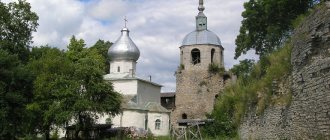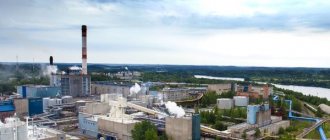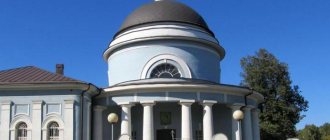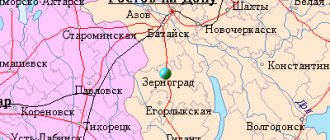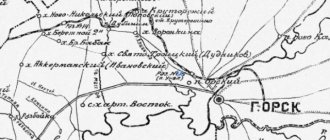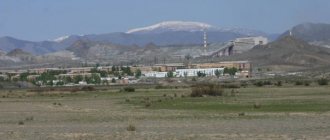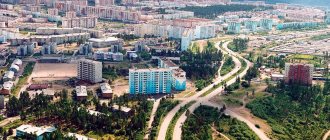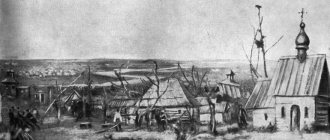Aksai
, a city in Russia, the administrative center of the Aksai urban settlement and district of the Rostov region, within the Aksai deanery of the Rostov-on-Don diocese. Located on the steep right bank of the river bend. Don, at the confluence of the river. Aksai (Don sleeve). An industrial satellite city 16 km from Rostov-on-Don. Railway station of the North Caucasus Railway. Pier on the Don River. Near Aksay there is a bypass highway that goes around Rostov-on-Don from the east. Population - 45.1 thousand people. (2018)
- On the map: Yandex.Map, Google map
According to legend, on the slopes of the Kobyakova Balka in the Kobyakov settlement in 1185, in the camp of the Polovtsian Khan Kobyak, the captive Novgorod-Seversk prince Igor Svyatoslavovich, the hero of “The Tale of Igor’s Campaign,” languished.
Aksai was founded by the Don Cossacks in the second half of the 16th century as a town. First mentioned in 1569 as the village of Ust-Aksai
.
During the Azov campaigns of 1695-1696 by Peter I and subsequently in the fight against the Turks for Russia’s access to the southern seas, the village served as a guard post controlling the approaches to Cherkassk - at that time the center of the Don Army Region. In the 18th century, there was a system of earthen fortifications connected by underground passages and equipped with warehouses with food and weapons supplies. In the winter of 1783/84, A.V. was in the Ust-Aksai camp. Suvorov, commander of the Kuban Corps.
Until the 18th century, the town changed a number of names: Nizhnie Razdory
(discord - the confluence of two rivers and the land between them);
Kobyakovsky
(Kobyak is a Tatar personal name);
Atamansky
,
Nizhny
.
In 1720-1740, a royal and then a customs outpost was located on Aksai land.
In 1742 it was mapped as Ust-Aksai Stan
, where Aksai is “white sai” (sai is a Turkic word for “dry bed, ravine, stream in a ravine, river”).
In 1768, the first wooden Trinity Church with a chapel in honor of St. Nicholas the Wonderworker was built in Aksai. A little later, in 1783, on the site of the previous dilapidated one, a new stone church was founded. The main organizer of the new church was Father Vasily Petrov. Trinity Church was demolished in 1937. Now at this place there is the Walk of Fame of Heroes - Aksay residents.
Since 1791 - the village of Aksai
.
At the turn of the 19th century, the Aksai village was home to more than 5 thousand indigenous people and more than 2 thousand non-residents, there were 5 schools, a nautical class, three churches, 8 mills, one glass mill, 2 candle factories, 2 pottery factories and 7 fish factories.
In Aksai, narrow, stone-paved streets descend to the banks of the Don, and small bridges span the ravines. The main streets are lined with one- and two-story classicist houses from the 1st half of the 19th century with three windows on the main façade and side galleries.
The village of Aksayskaya developed rapidly and by the end of the first quarter of the 19th century it became one of the largest and most prosperous villages in the land of the Don Army.
The economic development of the Aksai village reaches its heyday in 1860-1863, when from Grushevsky copies (now the city of Shakhty) to the station. Aksai built the first railway on the Don. On January 1, 1864, railway traffic opened
Among the architectural monuments: the postal caretaker's house and postal station (19th century, classicism), Hodegetrievskaya Church (1897) in the Russian-Byzantine style.
On July 1, 1924, the Aksai rural district was formed with its center in the city of Nakhichevan-on-Don.
During the Great Patriotic War, the village was occupied by Nazi troops from November 21 to 29, 1941.
In 1957, the village of Aksai was transformed into the city of Aksai
.
In 1963, the Aksai district was abolished, and its territory was transferred to the Azov region. In 1965, after the change of the country's top leadership, the Aksai region was restored to its former borders.
The city has a local history museum, the Chemical Product Production Association, a canning factory, a glass factory, etc. A repair and operational base for the Volga-Don River Shipping Company fleet.
Historical reference
- The year of foundation of the city is considered to be 1570 - it was to this year that its first written mention in chronicles dates back to: a meeting between Turkish representatives and the Russian ambassador Novosiltsev took place at this place.
- In 1734, the outpost at Ust-Oksai was mentioned in a chronicle listing the royal outposts around the center of the Don Army - Cherkassk (Starocherkasskaya).
- In 1783 the Trinity Church was founded. In 1786 - Triumphal Gate.
- In 1797, it was decided to rename the settlement the Ust-Aksai village. The prefix was soon removed from the name.
- In the 1850s, nautical classes were opened in the village of Aksayskaya. 1854-1855 (Crimean War) - the years of the founding of the rowing flotilla.
- In 1868, the railway connecting the coal mines in the modern city of Shakhty with the country's railway network was extended to Rostov-on-Don and Aksai.
- In 1957, the city of Aksai officially appeared on the map of Russia for the first time. In 1965, it became the center of the Aksai region.
Kobyakovo settlement. Mysterious stories of Aksai
There are places where people have settled for thousands of years. These include the environs of ancient Aksay and the nearby Kobyakovo settlement, which it is no coincidence that experts call the pearl of South Russian archeology. And note that the place received this name even before the unique finds of the new millennium. You can get an idea of the significance of these new finds from the newspaper headlines: “Older than the Egyptian pyramids: ancient catacomb chambers discovered near Rostov”, “Don Pyramids. Rostov archaeologists found structures similar in age and technology to Egyptian ones.”
It turns out that in quite impressive territories from Donbass to the Rostov region, researchers, since 2000, have been discovering typically pyramidal structures, and the mounds they found are distinguished by the fact that they are covered with a stone shell like the Egyptian pyramids. And although they are inferior in size to Egyptian structures, the technology of their construction is the same - also stepped.
“I personally see this for the first time in my practice. So we can be proud that the Don has its own pyramids"
,” the head of the archaeological expedition, Igor Gudimenko, shares his impressions.
It is characteristic that unique pyramidal mounds were discovered during the construction of a new federal highway. This is not uncommon today.
During the construction of a new section of the Don highway around Aksai, mounds were also found that are more than 5 thousand years old. The most interesting finds awaited archaeologists when studying the Figurin mound. It has been known for a long time, but large-scale research began only with the implementation of road work.
Archaeologists have discovered catacomb chambers, a lot of ceramics, and copper objects. Perhaps new discoveries will answer the question of who the builders of the ancient dungeon near Aksai were, and at the same time they will lift the curtains on the secrets of the Kobyakov settlement.
What kind of secrets? There are many of them, and not all of them have answers today. But let's talk about everything in order.
Kobyakovo settlement is the name of the mound on the banks of the Don.
It is located in the small ancient town of Aksai, which, in turn, is considered a suburb of Rostov-on-Don. From the outskirts of one city to the outskirts of another is about one and a half kilometers.
Aksai is a place with very beautiful nature. The town is located at the confluence of the Don and the Aksai River.
Moreover, he appeared here quite a long time ago. Already in 1570, this place was mentioned in a letter from the head of the Russian embassy, Ivan Petrovich Novoseltsev, who was traveling to Turkey. In the message sent to Tsar Ivan Vasilyevich the Terrible, we read:
“...the Azov Sefer sent two people as bailiffs and an interpreter to Ivan for a meeting at the Oksai estuary near the Kobyakovo settlement...”
The further history of Aksai is closely connected with the Cossacks. It was also a village, first Ust-Aksai, and then simply Aksai. Afterwards it became a Cossack town. The presence of two rivers at once and the proximity of the sea, of course, determined the priority occupation of its inhabitants, and the Cossack status introduced its own specifics into it. That is why in 1850 special courses were organized here, called Nautical Classes. honorary justice of the peace, secretary of the Don Statistical Committee, secretary of the Don Regional Deputy Assembly) wrote about this
):
“All the local living conditions here were most favorable for naval rather than cavalry service. A boy of 7-8 years old can already easily handle a kayak and since childhood he has been hearing stories about exploits and adventures on the water. (...) On a skiff, an oak and a longboat, the Cossacks are not afraid to venture into the open sea, and on their fragile boats they sail across vast spaces. Such daredevils can form a contingent of excellent naval soldiers, especially since, in addition to courage, they all have broad mental development.”
However, the history of this place is much more ancient and mysterious.
There is an opinion that the Kobyakovo settlement was named after Khan Kobyak, who once captured Prince Igor, well known from the famous “Tale of Igor’s Campaign.” This is what local guides like to tell, who are not at all embarrassed by the fact that in the text of the ancient monument of literature, the khan is not called Kobyak at all, but Konchak.
And the real history of this mound, like the whole of Aksai, is so mysterious and dramatic that any historical detective can envy it. Moreover, its secret has not been revealed to this day. Rather, modernity only added to its mystery.
Let's start with the fact that after excavations carried out on the mound at the beginning of the last century, their leader, archaeologist, ethnologist, artist and musicologist, academician Alexander Aleksandrovich Miller, in his report to the scientific society of Rostov-on-Don, made on December 12, 1925, determined the significance fortifications, without hesitation in assessments:
“In terms of the number of cultures located one above the other, the Kobyakovo settlement is the most valuable in the USSR. Man lived here continuously for a number of millennia and left powerful cultural layers.”
The most ancient layers, as determined by archaeologists, date back to 5-7 millennia BC, but this culture has so far been little studied.
Above this layer, Copper Age layers with highly developed metallurgy were discovered. The copper melted right there on the spot. And here is the first riddle. Miller reports that here archaeologists found “a number of ceramics (ware) with in-depth ornaments. This ancient culture is known from numerous mounds in Spain, France and in our South. But nowhere in the world were there settled settlements of this culture. For the first time such a settlement was found at the Kobyakov settlement. The cessation of this Copper Age culture should be dated to 2000 BC.”
Brooches are cloak clasps from the Roman period.
Imported red-glazed pottery from the 1st–2nd centuries AD.
Beads from Egypt
Above these layers lay two more, the top of which was dated to the 6th-7th centuries BC.
Another mystery:
“For a number of millennia, people lived on the Kobyakov settlement without interruption. But, starting from the 6th to the 1st century BC, we observe a break of several centuries.”
Where did the inhabitants disappear for several centuries? And where did they come from again? Indeed, already from the first centuries of the new era, this place again became densely populated. Moreover, as excavations show, its inhabitants had extensive trade ties with both the Hellenic world and Egypt.
Another powerful cultural flourishing occurred between the 8th and 12th centuries AD.
However, such a serious application for status did not save this place from the colossal destruction that was brought to it by construction (starting, by the way, from tsarist times), military operations, and even current realities, because for some reason it was there that local entrepreneurs decided to build a shopping mall.
It must be said that Miller’s excavations mentioned above were not the first in the history of the mound. Back in 1436, when this territory was a trading post under the control of Venice, the Venetian merchant Iosaphato Barbaro arrived in Tang (present-day Azov) and spent 16 years here. It was he who undertook the first excavations on the mound. He attracted about 300 workers to this venture, and, they say, paid them in gold. According to the official version, he was looking for the gold of the Scythian kings there. Who and what told him about this mound is not known for certain, but no one saw any gold, despite the fact that in his diary, which was later published, Barbaro wrote: “ we found everything, as predicted, therefore even more believed..."
So what was predicted for them? What did they find in Aksai? And finally, what did you believe in even more?
Some researchers claim that this strange Venetian was part of a secret society of the Venetian nobility, which dreamed of making Venice the capital of the world. For these purposes, the society intended to collect in its hometown as many mystical artifacts from all over the world as possible. His envoys rushed to look for them everywhere, right up to the Egyptian pyramids. But the Venetian Barbaro was allegedly sent to the Aksai mound in order to find the entrance to ... the underworld. No, the subject of the search was not an ordinary dungeon, but, in fact, the entrance to Hades or Tartarus.
And, judging by the entry in the diary, the Venetian believed that this entrance had been found...
Already in the last century, during excavations in one of the dungeons, an ancient chapel was discovered. Maybe it was the mystics from Venice who were looking for her?
By the way, it’s worth telling about the underground world and treasures separately.
There are legends about treasures in these places. And about the gold of the Scythian kings (about 30 years ago it was finally discovered here), and about the gold of the Horde khans, and about the golden train of the Cossacks, who allegedly even managed to grab a golden horse weighing several tons in one of the Turkish cities that were then nearby weight. And here's what's interesting:
historical chronicles really tell about a sudden attack by the Cossacks on one of the Turkish fortresses. And the legends stubbornly continue to talk about the golden horse captured by the Cossacks. Only 120 Cossacks came out of the Kobyakov settlement, and a thirty-thousand-strong Turkish army was looking for them. But the Cossacks disappeared as if through the earth, and 10 days later they appeared in Cherkessk. But, according to legend, they hid their precious loot in the Kobyakov settlement.
There, according to other legends, one must look for 32 barrels of gold, which were hidden by the Cossacks after the abolition of the Zaporozhye Sich by Catherine II.
It seems that Kornilov’s officers hid gold here, and even dashing robbers.
The question involuntarily arises: “Why is everything here? What are they doing here - anointed with honey?
Apparently, it's all about the underground world. Moreover, not in the mythological, but in the literal sense. The fact is that under Aksai there is an entire underground city. And is it just the city? In fact, under the city there is a whole network of catacombs, some of the passages of which lead to that very mound-fortification. Local residents say that not so long ago many private houses had entrances to this underground network in their courtyards. At the end of the last century, archaeologist Khitsunov discovered an underground passage leading from the center of the ancient city to its port part. And there are many such moves.
Thanks to these dungeons, the Kobyakovo settlement occupies a special place on the archaeological map of Russia and has long held the palm in terms of the number of mystical incidents, legends, folk beliefs and unsolved mysteries.
True, today most of these passages are filled in, especially large ones are filled with tons of concrete. What happened? And where did these mysterious underground passages come from?
There is an opinion that the dungeons are the result of shell rock mining. Well, what can I say to this? Of course, shell rock extracted from the ground was used in construction. Where was he supposed to go? But why, one might ask, should we mine it under our houses? After all, he is exactly the same and nearby. If we are talking about quarries, isn’t it more logical to build them not under the city, but next to it? The version that seems much more plausible is that the underground passages were built just like passages, and that the material taken out of the ground was used economically. In addition, the city, located in such a strategically convenient place, was constantly under pressure from outside, and these same catacombs helped the local residents very seriously.
But the intrigue begins to spiral in earnest after the military becomes interested in these underground spaces. Back in Soviet times, they planned to create an underground headquarters here in case of war.
But this idea soon had to be abandoned.
Of course, during this period, a detailed study of passages begins, drawing up detailed maps, and drawing communication lines. And then a frightening incident occurs - one of the soldiers disappears. They are looking for him and cannot find him. An entire unit is sent to search and also disappears without a trace. The story ends tragically, with several soldiers found without signs of life. They also find a walkie-talkie, cut like a scalpel. When they disassembled it, they did not find a single microcrack on the boards. What did they use to cut it? And most importantly - who? Or what?
The reaction of the military puzzled everyone even more. Instead of seriously investigating this incident, they hastily fold up, and all entrances to this dungeon are filled with concrete. What did they find there to make such a decision?
But the matter did not end there either. The military is not giving up on their idea. They simply move to another bridgehead and begin to explore these dungeons from the other side, from the so-called Mukhina Balka. Entrances to the dungeon are also found there. The military is building some kind of secret facility there.
What you see below are clearly traces left by military equipment; the walls look painfully smooth.
Soon the city is shaken by a series of tremors.
For many years the details of this story were not discussed and it was almost forgotten. But different times have come. The secret facility was abandoned, and curious people poured in. But they found only abandoned catacombs, tunnels, in some places with concrete finishing, and the same filled-up or walled-up passages.
Information began to appear that armored vehicles were being tested at this facility for the effects of a directed explosion. This is understandable; it was impossible to hide from the population the fact that heavy equipment was entering the catacombs. But bad luck, there were noticeably fewer people leaving than arriving.
Some researchers tried to suggest that the tanks, like the soldiers, simply fell into karst sinkholes. Indeed, in this place near Aksai at a depth of 40 meters there is an underground lake, and at a depth of 250 meters there is an entire underground sea. But a hole of such size that tanks, and more than one, could fall into it, is difficult not to notice.
Local residents also talk about other miracles encountered by those who dare to descend into the dungeon of the Kobyakov settlement. Either the walls ahead suddenly begin to converge, then the floor in front of those walking suddenly collapses, and then appears again. Most likely, a cunning system of traps is installed in the dungeon; if you step on an invisible bolt, the ground under your feet collapses, or, conversely, the wall moves away and opens the entrance to a new cave.
And another interesting fact. All Aksay churches are also connected to each other by underground passages.
Phenomena continue to swarm around this place, for which official science cannot find an explanation.
Here is one of those moments. The curator of the Customs Museum, Vyacheslav Zaporozhtsev, said that he once saw a light in the basement from which he had just left, having locked it for the night and turned off the lights. He returned and saw in the gallery a lady in a white dress of the 19th century style. And after that he saw her more than once.
He also reported that several times local residents saw a certain ferocious beast of an unknown breed in randomly discovered entrances to the dungeon. The dogs were terrified of him. And this despite the fact that all the predators in the area were removed several decades ago. But on many objects found in Aksai, with enviable regularity, an image of a strange animal resembling a wolf with huge fangs is found. There are no such images anywhere else in the world.
So who lives in the ancient dungeons of the Kobyakovo settlement mound? Where do they lead? What kind of underground world had access to the surface in the Aksai region? Was it by chance that different people brought gold here at different times? And how many millennia does the culture go back deep into the planet? And, most interestingly, how many millennia does the history of communication between this culture and our Ancestors go back to?
So far there are more questions than answers. But perhaps the discovery of the Don pyramids will prompt researchers to an even more detailed study of the Kobyakov settlement, which, even minus all its secrets, occupies a special place in one of the most artifact-rich local history routes called the “Silver Horseshoe of the Don.”
Routes on the map of Aksay. Transport infrastructure
Aksai occupies an important place on the transport map of Russia - the Federal Highway M4 "Don" , connecting Moscow with Voronezh, Rostov-on-Don, Krasnodar, Novorossiysk.
Almost all regional and regional highways connecting Rostov-on-Don with the southwestern settlements of the region also pass through Aksai.
The city is connected by regular bus services to all settlements of the Aksai region, major cities of the region, and Rostov-on-Don.
Suburban passenger trains (including electric trains) have a stop at the Aksai railway station (Aksai, Naberezhnaya, 2). The city also has the Steklo railway station. Long-distance trains do not have stops in Aksai.
There are three berths in Aksai, which are not currently operational.
Pages of the city's history
The city of Aksai is located on a steep bank at the confluence of the Aksai River with the Don, and occupies an advantageous geographical position, which provides it with strong connections not only with other cities and districts of the region, but also with all regions of the country. It is connected to the Krasnodar and Stavropol territories, the republics of the North Caucasus and Transcaucasia by the Don water artery and railway, gas pipeline. The Don federal highway creates opportunities for connections with almost all of Russia. The population of the city of Aksay is 36.5 thousand people. Two kilometers away is the millionaire city, the regional center - Rostov-on-Don. The first documentary evidence of the existence of a Cossack settlement within the current Aksai dates back to 1570: state archival documents (a letter from Ambassador I.P. Novosiltsev to Ivan Vasilyevich the Terrible) speak of a meeting with the envoy of the Turkish Sultan at the “Aksai mouth” near the Kobyakov settlement. On July 7, 1570, I. Novosiltsev sent a letter to Tsar Ivan Vasilyevich (the Terrible) with information about the completion of the first stage of the embassy, in which, in particular, he said that “Azov Dizdar Sefer sent Agu Zakafei to a meeting at the Ocean estuary near Kobyakovo.” Thus, July 7, 1570 may well be accepted as the date of birth of the city of Aksai. From that time on, Cossacks and Turks, when escorted through their territories, exchanged ambassadors here on their way to Turkey and Russia. Located here, in the border strip, the Cossack town 1 was repeatedly subjected to devastating raids by the Turks, Crimean Tatars and Nogais. However, the convenient location on the high bank at the confluence of the Aksai River with the Don, at the crossroads of land roads leading to the capital of the Don Army - Cherkassk, attracted people here again and again. What was destroyed was restored, but often under a new name.
An archival document from 1734, listing the royal outposts around Cherkassk, says: “The first, at Ust-Oksai, where, usually during a flood, Cossacks and widows, Cossack wives with children, most of them” leave Cherkassk and almost every year They live all summer, and at the same time there is bargaining with visiting Molorussians in the purchase and exchange for fish of bread and other things that some of the local people, like in a border place, have their own pleasure.” And only now the name of the settlement includes the word “Aksai” after the name of the river flowing here (from the Turkic “Ak-su” - white water). In 1742, this Cossack settlement was put on the map as “Ust-Aksai Stan”. The inconvenient position of “Don Venice” - the capital of the Don army of the city of Cherkassk, constantly flooded by spring waters, from the 1770s increasingly forced people to think about moving the main Cossack town to a new location . The gaze of the Cossack leaders increasingly turned to the familiar place where there was “the lower transportation across the Aksai River.
From 1775 (until 1811), the Cherkassy district was administratively controlled by detective authorities, who most of the time were already in the Ust-Aksai camp.
In 1783, construction of a stone Trinity Church began in Aksai with the boundaries of St. Nicholas the Wonderworker and Great Martyr George the Victorious. And “the multi-tiered, carved, gilded iconostasis of this church is of excellent workmanship, built in St. Petersburg by the famous architect Rastrelli.” (Fig. 4) Here in 1786, “the Triumphal Gate was made by hire of the clerk Budennov.
In 1791, the Ust-Aksai camp was renamed the Aksai village. When it was finally decided to move the capital of the Don Army to a new location, the village of Aksayskaya, among other localities, was intended to be occupied by a new city. The main reason, as evidenced by archival documents, is why the capital of the Don was not moved here under M.I. Platov, there was a fear that the commercial activities of Aksai, as well located, would lead to a decline in the military spirit of the Cossacks and the oblivion of the heroism of their glorious ancestors. Indeed, the geographical position of Aksai was so favorable that its neighbors, the commercial and industrial cities of Rostov and Nakhichevan, could not compete with it for a long time. From the founding of the city of Novo-Cherkassk in 1805 until 1837, the Cossacks at the highest levels of government raised the issue of moving the capital of the Don Army, now from Novocherkassk to Aksai. But the attempt to transfer it failed... The construction of a major Olginsky dam across the entire Don borrow area (valley) in 1854 further contributed to the benefits of the village. Meanwhile, Rostov, which until the 1850s was a village in comparison with the Aksai village, gradually grew due to its position and finally became the center of commercial and industrial activity in the lower reaches of the Don. During the Crimean War of 1853-1856, Aksai was given a special role. In case of possible advance of Turkish and English steamships with landing forces along the Don River here, during the spring flood of 1856, the third line of defense was supposed to block their path. On the dam between the villages of Aksayskaya and Olginskaya, two bridge fortifications and seven lunettes were built, armed with sixty foots of half-pound unicorns.
In 1854-1855, the Azov Rowing Flotilla was built at the mouth of the Aksai River, and sailing classes were opened a little later. A gunpowder factory, located on a gentle slope of a ravine on the northwestern outskirts of the village, began producing products.
The Aksai village reached the apogee of its development in the early 1860s, when the first railway on the Don was built from Grushevsky mines (Shakhty) to Aksai. The encyclopedic reference book of Brockhaus and Efron in 1890 characterized the village very sparingly: “it has a salt warehouse, two candle factories and 5,606 inhabitants, engaged mainly in fishing, as well as grain, wood and iron trade... there is the main transportation through Don on the way to the Caucasus...” By this time, preparatory nautical classes (schools), well-known in the Don Army Region, were operating in the village, although not as equipped as the nautical school in the city of Rostov. The school accepted children from 13 to 17 years old into the 1st grade, and 1-2 years older into the 2nd and 3rd grades. Students had to be in good health and have normal vision. A fee was charged for studying at the school: from the students of the villages who provided funds for the maintenance of the school - 5 rubles, from the rest - 10 rubles per year. In the village there was a public reading room, a postal and telegraph office and... a “funeral cash register”. There were 1060 households in the village, of which 900 were Cossacks.
Mostly the non-Cossack class lived on the farms. There were 7 fish factories, 2 pottery factories, 1 glass factory, 12 forges, 1 steam mill, 2 water mills and 5 wind mills. The Cossacks of the village were sent to serve in the Life Guards of the Ataman Cossack Regiment, in the army batteries and the 7th Don Cossack Regiment, as well as in local teams.
Merchants and entrepreneurship at the beginning of the First World War in the Aksai village were represented by the wine trader S.A. Gertsov, haberdashery and manufactory I.E. Khaspekov, pharmaceutical goods of G.L. Hoffman, bakeries, trade in grain, flour, glass (glass factory of V.A. Dobrovolsky), etc.
The revolution of 1917 found the village of Aksai during the period of its peaceful and calm growth into capitalist relations.
During the Great Patriotic War, the village was occupied by German troops twice.
After the Great Patriotic War, the village steadfastly survived the difficult post-war years and was actively involved in post-war construction. In 1954, the first large industrial enterprise, Aksaykardandetal, appeared in the village, attracting a significant part of the rural residents. The appearance of the village during these years was not very impressive.
Since 1957, according to the Decree of the Presidium of the Supreme Soviet of the RSFSR dated December 23, 1957, Aksai became a city of district subordination. In subsequent years, the city is actively being improved, housing construction is underway, new microdistricts are emerging - the city, stubbornly climbing the steep slopes, goes to the plateau, into the steppe. Instead of the ferry crossing across the Don that operated in the post-war period, in 1965 a road bridge connected both banks of the river, and exactly 30 years later, in 1995, a second bridge appeared nearby, providing a convenient connection between Rostov-on-Don and Aksai and the southern regions. onami of the Rostov region and the North Caucasus. Today's Aksai is no longer a dormant and quiet village, but a large industrial center with an intensively developing class of entrepreneurs. The city has a cannery, a brewery, a ship repair plant, enterprises of household chemicals, building materials, transport and construction organizations. A new shipyard, Don Cassens, has recently been built, producing cargo river vessels. The large enterprise Sovtransavto-Rostov provides international transportation of various goods.
Sights of Aksay
- Museum complex "Customs Outpost" - contains exhibits of everyday life, maps, manuscripts, images of weapons of customs officers of the 18th century.
- Museum "Post Station 19th Century".
- Temple of the Icon of the Mother of God "Hodegetria".
- “Suvorov's House” is a military history museum, exhibits from the mid-20th century.
- Military-historical museum of the city of Aksay . The exhibition includes Soviet and Russian equipment, tunnels, and the underground command post of the SKO.
- Underground passage system.
Aksai and Aksai region today
- Home /
- Area /
- Story /
- Aksai and Aksai region today /
- Banners on the left
Aksai district (center - Aksai) has existed as an administrative unit since 1924. Aksai district is located in the southwestern part of the Rostov region and adjoins the city of Rostov-on-Don on the eastern side.
In the south, the region borders on the Kagalnitsky and Zernogradsky districts, in the southwest it borders on the city of Bataysk; in the west - with the city of Rostov-on-Don; in the north-west - with the Myasnikovsky district; in the north – with the Rodionovo-Nesvetaysky and Oktyabrsky districts; in the northeast - with the city of Novocherkassk and in the southeast - with the Bagaevsky district.
Aksai district is divided into 11 territories: an urban settlement is the city of Aksai and ten rural settlements - Bolshelogskaya, Verkhnepodpolnenskaya, Grushevskaya, Istominskaya, Leninskaya, Mishkinskaya, Shchepkinskoye, Olginskaya, Rassvetovskaya, Starocherkasskaya.
Aksai district covers an area of 1162 square meters. km.
The city of Aksai is located on the steep right bank of the Don River, at the place where the Aksai River flows into it (the right branch of the lower Don, 79 km long), 17 km northeast of Rostov-on-Don. The city has a pier on the Don River, as well as a railway station. The deviation from Moscow time is 0 hours, geographic latitude is 47°16′, geographic longitude is 39°52′.
About 114 thousand 700 people live in the Aksai region (according to data for 2021).
There are about two thousand enterprises in the district, and more than three thousand entrepreneurs operate.
Since 2009, a significant increase in the number of workers in enterprises and organizations of the district has been recorded. This is explained by the creation of new jobs in the district in connection with the commissioning of large facilities - AUCHAN, MEGA, Logopark-Don LLC, and the opening of a construction market "Leroy Merlin", multifunctional shopping complex "Lenta", cars, "Toyota", "Ford", etc.
Industry in the region is represented by such large enterprises as LLC PKF ATLANTIS-PAK, LLC KF Mishkino, LLC Europolymer.
On the territory of the region in the Starocherkassky rural settlement there is one of the largest golf courses.
The district budget continues to maintain a social orientation. About 80% of budget funds are spent on social issues.
The area pays great attention to the preservation of historical heritage. The city has a local history museum, museum complexes “Customs Outpost”, “Post Station”, and a Military Historical Complex. All these objects are united into the “Military History Museum of Aksay”. There are local history museums in the region: Aksai Military History Museum named after. N.D. Gulaev and Starocherkassk Historical and Architectural Museum-Reserve.
Main streets on the map of Aksay
- Sadovaya street . It runs through the center of Aksay, bordering the street. Cossack and Ave. Lenin. On the street On Sadovaya there are many green areas and the Aksai city cemetery.
- Lenin Avenue . Intersects with the street. Sadovaya, Aksaisky Avenue. Here is the Aksai Central District Hospital, the Old City Cemetery, and the Aksai Market.
- Lunacharsky Street . Located in the south of Aksay, it intersects with Tolpinsky, Sovetskaya, Oktyabrskaya streets.
- Chapaeva street. On the map of Aksay with houses you can see here the MFC, the Pension Fund, and the “Zdravitsa” sanatorium.
- Western street . Part of the M-4 Don highway runs along it, and has access to the Aksai Bridge on one side and the Novocherkassk Highway on the other. There are many green areas, an industrial zone, and the LEDAX sports complex.
Aksai
Aksai is a small town near Rostov-on-Don. No wonder it is called the bedroom of “Rostov-papa” and compared to Khimki near Moscow. It's just a stone's throw from one city to another. It’s only 16 kilometers, but this path runs along a busy federal highway to the Black Sea. Rush hour is around the clock here. Not only are cars from Central Russia rushing to the sea, but Mega and Auchan were recently built at the transport interchange. The entire Rostov region comes here for food and clothing.
Stroll the city streets using Google Panoramas
However, Aksay residents do not grumble about roadside dust, but open roadside cafes for travelers. Those who are more cunning run these cafes, those who are simpler work there. Cooks from roadside cafes earn only 7 thousand, while the average income of an Aksay resident, according to the city administration, is 23 thousand 600 rubles. Why are food service workers paid so little? Maybe they expect them to eat and steal food? Or maybe the city administration is confusing something with average earnings. The cuisine in roadside cafes is very different, to suit every taste and budget. The most exquisite dishes can cost up to 500 rubles (the chef’s salary is enough to eat as many as 6 times).
Winter Aksai. Photo by Tatyana (https://fotki.yandex.ru/users/rabota-krd)
The name Aksai comes from the Turkic “Akso” - white water. The city stands on the river of the same name, at its confluence with the Don. The first settlements appeared here before our era. Aksai attracts adventurers and ancient civilizations. For example, on the territory of the city there is a Kopikovo settlement, it is more than 3000 years old. This site could become a magnet for thousands of tourists, but now it is just dug up hills. And only a person with a very rich imagination can imagine how people lived here 3 thousand years ago.
Now people in Aksai live differently. The city consists of two parts - old and new. In one there are old Cossack kurens with a view of the Don and country roads, but in the new Aksai there are newly built high-rise buildings.
Once upon a time, Aksai could have become the capital of the Don Cossacks, but the city was not destined to unite the south of Russia. Despite the fact that this place was never flooded during the flooding of the Don, unlike Cherkassk, the Cossacks changed their minds about moving the capital here. The Aksai village was too close to the Turkish border, where it was quite restless.
Now the city is very far from the Turkish border. And where the Cossacks used to be trained, there is now an ice palace, built quite recently. The new hockey school took the issue of personnel very seriously. A coach from abroad, Vladimir Gavrilov from Kazakhstan, was invited especially for young hockey players. It is he who is now raising new Kovalchuk, Ovechkin and Malkin. Children, as in the best Soviet years, play hockey in Aksai completely free of charge. Adults also look up to little hockey players. The city already has several amateur teams that play each other in the evenings.
In addition to hockey, Aksay residents love to go into dungeons, fortunately there are plenty of them in the outskirts of the city. The favorite place of Rostov stalkers is Mukhina Balka. Here, in the middle of the last century, a shelter was dug in case of nuclear war for the headquarters of the North Caucasus Military District. Tourists regularly visit the Aksai dungeons. At one time, they were looking for Scythian gold and a monster that destroyed livestock. Haven't found anything yet. According to legend, in 1953 a huge monster killed a military detachment. The young people went down into the dungeon to investigate and never saw the white light again. There are no documented facts about the existence of the monster, but it is known for certain that Satanists used to gather in the dungeons until stalkers kicked them out and destroyed their altar.
Alley of Heroes in Aksai. Photo by Larisa Avdonina (https://fotki.yandex.ru/users/avdonina-lara2014)
Among the real horrors that took place near Aksai, one can highlight the story of the murder of the family of special forces soldier Dmitry Chudakov. His Zhiguli, model fifteen, with bullet holes in the windows, was found early in the morning of July 8, 2009, on the side of the M-4 Don highway. The car was shot from both sides with a Saiga, and then the lieutenant colonel's wife and two children were finished off with knives. Perhaps the military family became victims of a banal robbery. Maybe the military officer was being taken revenge for something. Otherwise the city is quite calm. There are not even interethnic conflicts between Russians and Caucasians.
Housing in the city, for its size, is quite expensive. A square meter costs 38,600 or more. It turns out that a one-room apartment costs about two million rubles. Two-room apartment - 2.5 million rubles.
There is no special work in the city; many locals work in Mega and Auchan. Even more residents go to work in Rostov-on-Don. The Aksai-Rostov-on-Don minibus costs 17 rubles. The same situation applies to studies. In Aksai itself you can find work in construction, since they build high-rise buildings, cottages, and dachas.
Aksai's status as a Rostov sleeping bag is also strengthened by young people. Young people enter Rostov universities, and only go to their hometown on weekends to see their parents and take money from them.
Who might be interested in Aksai for relocation? Pensioners from Rostov and people who do not have enough money for real estate in the regional center.
Economy and industry of Aksay
In the structure of the city’s economy, 60% is the turnover of companies in the consumer market, 15% each is construction and industry, the rest is agriculture, transport and other areas.
80% of industrial production is represented by companies in the processing industry, mainly plastic and rubber products. 15% - metalworking and mechanical engineering enterprises, mainly engaged in the production of spare parts for agricultural machinery and ship repairs. 10% of industrial turnover comes from the production of non-metallic mineral products.
Links[edit]
Notes[edit]
- ^ abcdefgh Law No. 340-ZS
- ^ abcdefgh Encyclopedia of Russian Cities
. Moscow: Great Russian Encyclopedia. 2003. p. 15. ISBN 5-7107-7399-9. - ^ a b Federal State Statistics Service (2011). “All-Russian Population Census 2010. Volume 1" [All-Russian Population Census 2010, vol. 1]. All-Russian Population Census 2010 [All-Russian Population Census 2010]
. Federal State Statistics Service. - "26. The size of the permanent population of the Russian Federation by municipalities as of January 1, 2021". Federal State Statistics Service. Retrieved January 23, 2021.
- ^ abcde Law No. 240-ZS
- "On the Calculation of Time". Official Internet portal of legal information
. June 3, 2011. Retrieved January 19, 2021. - Post office. Information and computing center of OASU RPO. ( Post office
).
Search for postal service objects ( postal Search for objects
) (in Russian) - ↑
Federal State Statistics Service of Russia (May 21, 2004).
“The population of Russia, the constituent entities of the Russian Federation as part of federal districts, urban settlements, settlements, settlements of 3 thousand or more people” [Population of Russia, its federal districts, federal districts, districts, urban settlements, rural settlements - administrative centers and rural settlements with a population of more than 3,000 people] (XLS). All-Russian Population Census 2002
. - “All-Union Population Census of 1989. The current population of union and autonomous republics, autonomous regions and districts, territories, negative phenomena, urban settlements and rural district centers” [All-Union Population Census of 1989: current population of union and autonomous republics, Autonomous regions and districts , territories, regions, districts, towns and villages performing the functions of district administrative centers. All-Union Population Census of 1989 [All-Union Population Census of 1989]
.
Institute of Demography of the National Research University: Higher School of Economics [Institute of Demography of the National Research University: Higher School of Economics]. 1989 - via Demoscope Weekly
. - Sights of Aksay
Rostov-on-Don is the region's leader in population
Rostov-on-Don is the capital of the Rostov region, its scientific, educational, financial and industrial center. It is also a major transport hub. This is the only metropolis in the region, which is far ahead of all other settlements. With a population of 1,130,305 people, it ranks 10th in Russia. In terms of agglomeration composition, it is 4th in the country (2,160,000 citizens). Rostov-on-Don is very important in the economic and cultural life of the country. Its unofficial names: Rostov-papa, Gates of the Caucasus, Don capital.
Geographically, Rostov is located on the banks of the large Don River, flowing through the European part of the Russian Federation. It divides the metropolis into two parts. Not far from it are Aksai (135,000 inhabitants) and Bataysk (about 250,000). At the moment, the situation is such that they are almost merging into a single conglomerate. The cities have strong economic and transport connections. The distance between them has been reduced to walking distance. The shortest distance between the buildings of Rostov and Aksay is 34 meters. After the metropolis absorbs its satellites and the legal recognition of this fact, the metropolis will take 3rd place in the country.
Rostov-on-Don was founded as a customs point by imperial decree (1749). The favorable geographical position contributed to the creation of trade routes through Rostov. Its port was important; trade with the Mediterranean countries was carried out from here. The city began to grow rapidly and become richer. In addition to merchants, many people flocked here to work in the port and in factories. Now Rostov-on-Don is one of the richest and economically prosperous settlements located in the south of the country. The largest production facilities in various fields are concentrated here. The most important of them:
- Rostselmash is a well-known manufacturer of grain harvesting equipment. He owns up to 60% of the Russian market;
- "Rostvertol" - an aircraft manufacturer - is the largest cigarette manufacturer in the Russian Federation;
- Gloria Jeans is the largest clothing factory, a federal chain of retail stores;
- TagAZ - automobile - manufacturer, supplier of sunflower oil.
There are many Russian and foreign banks operating in Rostov. Federal retail chains are concentrated here, generating huge trade turnover (Magnit, Sportmaster, Tekhnosila and others). Enterprises provide jobs to the entire population of the metropolis. The unemployment rate here is extremely low. The average salary is higher than in Russia as a whole. Rostov-on-Don has sea and river ports, an international airport, and a network of railways and buses. There are trolleybus, tram and electric train routes. Due to the large number of vehicles, traffic congestion occurs periodically. The city authorities are planning the construction of a metro and a high-speed tram system in order to relieve congestion on transport networks.
